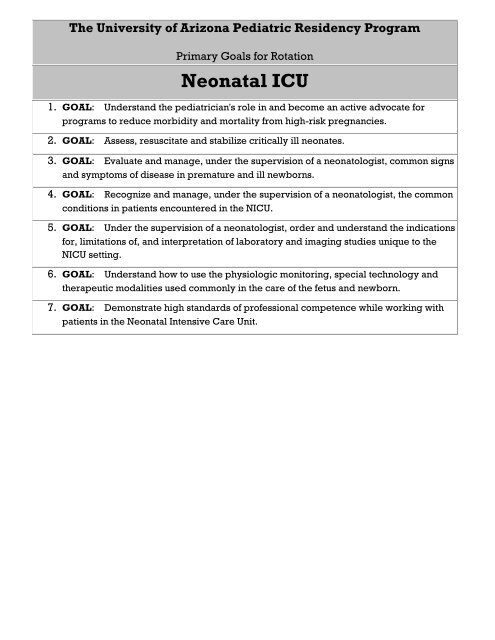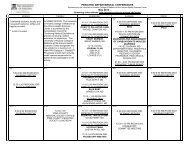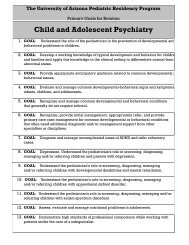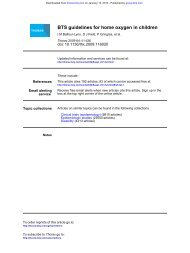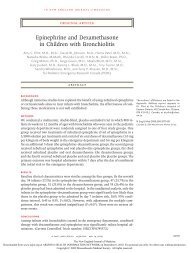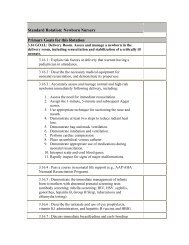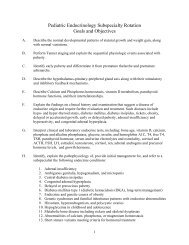Neonatal ICU - University of Arizona Department of Pediatrics
Neonatal ICU - University of Arizona Department of Pediatrics
Neonatal ICU - University of Arizona Department of Pediatrics
You also want an ePaper? Increase the reach of your titles
YUMPU automatically turns print PDFs into web optimized ePapers that Google loves.
The <strong>University</strong> <strong>of</strong> <strong>Arizona</strong> Pediatric Residency Program<br />
Primary Goals for Rotation<br />
<strong>Neonatal</strong> <strong>ICU</strong><br />
1. GOAL: Understand the pediatrician's role in and become an active advocate for<br />
programs to reduce morbidity and mortality from high-risk pregnancies.<br />
2. GOAL: Assess, resuscitate and stabilize critically ill neonates.<br />
3. GOAL: Evaluate and manage, under the supervision <strong>of</strong> a neonatologist, common signs<br />
and symptoms <strong>of</strong> disease in premature and ill newborns.<br />
4. GOAL: Recognize and manage, under the supervision <strong>of</strong> a neonatologist, the common<br />
conditions in patients encountered in the N<strong>ICU</strong>.<br />
5. GOAL: Under the supervision <strong>of</strong> a neonatologist, order and understand the indications<br />
for, limitations <strong>of</strong>, and interpretation <strong>of</strong> laboratory and imaging studies unique to the<br />
N<strong>ICU</strong> setting.<br />
6. GOAL: Understand how to use the physiologic monitoring, special technology and<br />
therapeutic modalities used commonly in the care <strong>of</strong> the fetus and newborn.<br />
7. GOAL: Demonstrate high standards <strong>of</strong> pr<strong>of</strong>essional competence while working with<br />
patients in the <strong>Neonatal</strong> Intensive Care Unit.
1. GOAL: Understand the pediatrician's role in and become an active advocate for<br />
programs to reduce morbidity and mortality from high-risk pregnancies.<br />
A. Identify and describe strategies to reduce fetal and neonatal mortality,<br />
including use <strong>of</strong> group B strep prophylaxis, perinatal steroids.<br />
B. Understand and know how to access:<br />
1. Basic vital statistics that apply to newborns (neonatal and<br />
perinatal mortality, etc)<br />
2. Prenatal services available in one's region<br />
3. Tests commonly used by obstetricians to measure fetal well-being<br />
4. <strong>Neonatal</strong> transport systems<br />
C. Describe effective intervention programs for teens and other high-risk<br />
mothers.<br />
D. Recognize potential adverse outcomes for the fetus and neonate <strong>of</strong> common<br />
prenatal and perinatal conditions, and demonstrate the pediatrician's role in<br />
assessment and management strategies to minimize the risk to the fetus and/or<br />
newborn in the following situations:<br />
1. Maternal infections/exposure to infection during pregnancy<br />
2. Fetal exposure to harmful substances (alcohol, tobacco, environmental<br />
toxins, medications, street drugs)<br />
3. Maternal insulin-dependent diabetes and pregnancy-induced glucose<br />
intolerance<br />
4. Multiple gestation<br />
5. Placental abnormalities (placenta previa, abruption, abnormal size,<br />
function)<br />
6. Pre-eclampsia, eclampsia<br />
7. Chorioamnionitis<br />
8. Polyhydramnios<br />
9. Oligohydramnios<br />
10. Premature labor, premature ruptured membranes<br />
11. Complications <strong>of</strong> anesthesia and common delivery practices (e.g.,<br />
Caesarian, vacuum, forceps assisted, epidural, induction <strong>of</strong> labor)<br />
12. Fetal distress during delivery<br />
13. Postpartum maternal fever or infection<br />
14. Maternal blood group incompatibilities<br />
15. Other common maternal conditions having implications for the infant?s<br />
health such as lupus, HELLP syndrome, maternal thrombocytopenia<br />
2. GOAL: Assess, resuscitate and stabilize critically ill neonates.<br />
A. Explain and perform steps in resuscitation and stabilization, particularly<br />
airway management, vascular access, volume resuscitation, indications for and<br />
techniques <strong>of</strong> chest compressions, resuscitative pharmacology and<br />
management <strong>of</strong> meconium deliveries.<br />
B. Describe the common causes <strong>of</strong> acute deterioration in previously stable N<strong>ICU</strong><br />
patients.
C. Function appropriately in codes and neonatal resuscitations as part <strong>of</strong> the<br />
N<strong>ICU</strong> team by:<br />
1. Participating in resuscitations<br />
2. Completing <strong>Neonatal</strong> Resuscitation Program (NRP) or comparable training<br />
3. Using neonatal resuscitation drugs appropriately<br />
3. GOAL: Evaluate and manage, under the supervision <strong>of</strong> a neonatologist, common<br />
signs and symptoms <strong>of</strong> disease in premature and ill newborns.<br />
A. Under supervision, evaluate and manage patients with the signs and symptoms<br />
that present commonly in the N<strong>ICU</strong> (examples below).<br />
1. General: feeding problems, history <strong>of</strong> maternal infection or<br />
exposure, hyperthermia, hypothermia, intrauterine growth<br />
failure, irritability, jitteriness, large for gestational age, lethargy,<br />
poor post-natal weight gain, prematurity (various gestational<br />
ages)<br />
2. Cardiorespiratory: apnea, bradycardia, cyanosis, dehydration,<br />
heart murmur, hypertension, hypotension, hypovolemia, poor<br />
pulses, respiratory distress (flaring, grunting, tachypnea), shock<br />
3. Dermatologic: birthmarks, common skin rashes/conditions,<br />
discharge and/or inflammation <strong>of</strong> the umbilicus, hyper- and<br />
hypopigmented lesions, proper skin care for extreme prematures<br />
4. GI/surgical: abdominal mass, bloody stools, diarrhea, distended<br />
abdomen, failure to pass stool, gastric retention or reflux,<br />
hepatosplenomegaly, vomiting<br />
5. Genetic/metabolic: apparent congenital defect or dysmorphic<br />
syndrome, metabolic derangements (glucose, calcium, acidbase,<br />
urea, amino acids, etc.)<br />
6. Hematologic: abnormal bleeding, anemia, jaundice in a<br />
premature or seriously ill neonate, neutropenia, petechiae,<br />
polycythemia, thrombocytopenia<br />
7. Musculoskeletal: birth defects and deformities, birth trauma and<br />
related fractures and s<strong>of</strong>t tissue injuries, dislocations<br />
8. Neurologic: birth trauma related nerve damage, early signs <strong>of</strong><br />
neurologic impairment, hypotonia, macrocephaly, microcephaly,<br />
seizures, spina bifida<br />
9. Parental stress and dysfunction: anxiety disorders, child abuse<br />
and neglect, poor attachment, postpartum depression, substance<br />
abuse, teen parent<br />
10. Renal/urologic: abnormal genitalia, edema, hematuria, oliguria,<br />
proteinuria, renal mass, urinary retention
4. GOAL: Recognize and manage, under the supervision <strong>of</strong> a neonatologist, the<br />
common conditions in patients encountered in the N<strong>ICU</strong>.<br />
A. Under supervision, evaluate and manage patients with conditions that present<br />
commonly in the N<strong>ICU</strong> (examples below):<br />
1. General: congenital malformations<br />
2. Cardiovascular: cardiomyopathy, congenital heart disease (cyanotic and<br />
acyanotic--e.g., common disorders such as patent ductus arteriosus,<br />
ventricular septal defect, tetralogy <strong>of</strong> Fallot, transposition <strong>of</strong> the great<br />
arteries), congestive heart failure, dysrhythmias (e.g. supraventricular<br />
tachyarhythmia, complete heart block), pericarditis<br />
3. Genetic, endocrine disorders: abnormalities discovered from neonatal<br />
screening programs as they affect the premature infant, common<br />
chromosomal anomalies (Trisomy 13, 18, 21, Turner's), inborn errors <strong>of</strong><br />
metabolism, infant <strong>of</strong> a diabetic mother, infant <strong>of</strong> a mother with thyroid<br />
disease (e.g. maternal Graves Disease), uncommon conditions such as<br />
congenital adrenal hyperplasia, hypothyroidism, hyperthyroidism<br />
4. GI/nutrition: biliary atresia, breast feeding support for mothers and infants<br />
with special needs (high risk premature, maternal illness, multiple birth,<br />
etc.), complications <strong>of</strong> umbilical catheterization, gastroesophageal reflux,<br />
growth retardation, hepatitis, hyperbilirubinemia, meconium plug,<br />
necrotizing enterocolitis, nutritional management <strong>of</strong> high risk neonates or<br />
those with special needs (cleft lip/palate, other facial anomalies, etc.)<br />
5. Hematologic conditions: coagulopathy <strong>of</strong> the newborn, erythroblastosis<br />
fetalis, hemophilia, hydrops fetalis, hyperbilirubinemia, splenomegaly<br />
6. Infectious disease: central line infections, Group B Streptococcal infections,<br />
hepatitis, herpes simplex, immunization <strong>of</strong> the premature neonate, infant <strong>of</strong><br />
mother with HIV, intrauterine viral infections, neonatal sepsis and<br />
meningitis, nosocomial infections in the N<strong>ICU</strong>, syphilis, ureaplasma,<br />
varicella exposure<br />
7. Neurologic disorders: central apnea, CNS malformations (e.g.<br />
encephalocele, porencephaly, holoprosencephaly), drug withdrawal,<br />
hearing loss in high risk newborns (prevention and screening),<br />
hydrocephalus, hypoxic-ischemic encephalopathy, intraventricular<br />
hemorrhage, retinopathy <strong>of</strong> prematurity, seizures, spina bifida<br />
8. Pulmonary disorders: atelectasis, bronchopulmonary dysplasia, meconium<br />
aspiration, persistent pulmonary hypertension <strong>of</strong> the newborn, pneumonia,<br />
pneumothorax, respiratory distress syndrome, transient tachypnea <strong>of</strong> the<br />
newborn<br />
9. Renal: acute and chronic renal failure, hematuria, hydronephrosis, oliguria,<br />
proteinuria<br />
10. Surgery [assess and participate in management under supervision <strong>of</strong> a<br />
pediatric surgeon or cardiac surgeon]: congenital heart disease, (cyanotic,<br />
patent ductus arteriosus, obstructive left-sided cardiac lesions, pre- and<br />
post-operative care), diaphragmatic hernia, esophageal or gut atresia,<br />
gastroschisis, omphalocele, intestinal obstruction, necrotizing enterocolitis,<br />
perforated viscus, Pierre Robin syndrome, volvulus
5. GOAL: Under the supervision <strong>of</strong> a neonatologist, order and understand the<br />
indications for, limitations <strong>of</strong>, and interpretation <strong>of</strong> laboratory and imaging studies<br />
unique to the N<strong>ICU</strong> setting.<br />
A. Demonstrate understanding <strong>of</strong> common diagnostic tests and imaging studies<br />
used in the N<strong>ICU</strong> by being able to:<br />
1. Explain the indications for and limitations <strong>of</strong> each study.<br />
2. Know or be able to locate readily gestational age-appropriate<br />
normal ranges (lab studies).<br />
3. Apply knowledge <strong>of</strong> diagnostic test properties, including the use<br />
<strong>of</strong> sensitivity, specificity, positive predictive value, negative<br />
predictive value, likelihood ratios, and receiver operating<br />
characteristic curves, to assess the utility <strong>of</strong> tests in various<br />
clinical settings.<br />
4. Recognize cost and utilization issues.<br />
5. Interpret the results in the context <strong>of</strong> the specific patient.<br />
6. Discuss therapeutic options for correction <strong>of</strong> abnormalities.<br />
B. Use appropriately the following evaluations that may have specific application<br />
to neonatal care:<br />
1. Serologic and other studies for transplacental infection<br />
2. Direct and indirect Coomb's tests<br />
3. <strong>Neonatal</strong> drug screening<br />
4. Cranial ultrasound for intraventricular hemorrhage<br />
5. Abdominal X-rays for placement <strong>of</strong> umbilical catheter<br />
6. Chest X-rays for endotracheal tube placement, air leak, heart size, and<br />
vascularity<br />
C. Use appropriately the following laboratory tests when indicated for patients in<br />
the neonatal intensive care setting:<br />
1. CBC with differential, platelet count, RBC indices<br />
2. Blood chemistries: electrolytes, glucose, calcium, magnesium, phosphate<br />
3. Renal function tests<br />
4. Tests <strong>of</strong> hepatic function (PT, albumin) and damage (liver enzymes,<br />
bilirubin)<br />
5. Serologic tests for infection (e.g., hepatitis, HIV)<br />
6. CRP, ESR<br />
7. Therapeutic drug concentrations<br />
8. Coagulation studies: platelets, PT/PTT, fibrinogen, fibrin split products, D-<br />
dimers, DIC screen<br />
9. Arterial, capillary, and venous blood gases<br />
10. Detection <strong>of</strong> bacterial, viral, and fungal pathogens<br />
11. Urinalysis<br />
12. CSF analysis<br />
13. Gram stain<br />
14. Stool studies<br />
15. Toxicologic screens/drug levels<br />
16. Other fluid studies (e.g., pleural fluid, joint fluid)<br />
17. Newborn screening tests
D. Appropriately use the following imaging or radiographic or other studies<br />
when indicated for patients in the N<strong>ICU</strong> setting:<br />
1. Chest X-ray<br />
2. Abdominal series<br />
3. Skeletal survey<br />
4. CT scans<br />
5. MRI<br />
6. Nuclear medicine scans<br />
7. Electrocardiogram and echocardiogram<br />
8. Cranial ultrasonography<br />
6. GOAL: Understand how to use the physiologic monitoring, special technology and<br />
therapeutic modalities used commonly in the care <strong>of</strong> the fetus and newborn.<br />
A. Demonstrate understanding <strong>of</strong> the monitoring techniques and special<br />
treatments commonly used in the N<strong>ICU</strong> by being able to:<br />
1. Discuss the indications, contraindications and complications.<br />
2. Describe the general technique for use in infants.<br />
3. Interpret the results <strong>of</strong> monitoring.<br />
B. Use appropriately the following monitoring and therapeutic techniques in<br />
N<strong>ICU</strong>.<br />
1. Physiologic monitoring <strong>of</strong> temperature, pulse, respiration, blood pressure<br />
2. Pulse oximetry<br />
3. <strong>Neonatal</strong> pain and drug withdrawal scales<br />
C. Demonstrate understanding <strong>of</strong> the following techniques and procedures used<br />
by obstetricians and perinatal specialists:<br />
1. Fetal ultrasound for size and anatomy<br />
2. Fetal heart rate monitors<br />
3. Scalp and cord blood sampling<br />
4. Amniocentesis<br />
5. Cardiocentesis<br />
6. Intrauterine transfusion including exchange transfusions<br />
7. Chorionic villus sampling<br />
D. Use appropriately the following treatments and techniques in the neonatal<br />
intensive care unit under supervision by the attending neonatologist,<br />
monitoring effects and anticipating potential complications specific to each<br />
procedure. (The degree <strong>of</strong> supervision should take into consideration the skill<br />
required, acuity <strong>of</strong> the patient, and relative risk <strong>of</strong> the procedure.)<br />
1. Oxygen administration by hood, CPAP or assisted ventilation<br />
2. Endotracheal intubation<br />
3. Administration <strong>of</strong> surfactant therapy<br />
4. Positive pressure ventilation and basic ventilator management<br />
5. Extracorporeal membrane oxygenation/nitric oxide therapy<br />
6. Phototherapy<br />
7. Umbilical arterial and venous catheterization<br />
8. Central hyperalimentation and parenteral nutrition
9. Enteral nutrition<br />
10. Analgesic, sedatives and paralytics<br />
11. Blood and blood product transfusions, including exchange transfusion<br />
12. Vasoactive drugs (pressors and inotropes)<br />
13. Judicious use <strong>of</strong> antibiotics<br />
14. Administration <strong>of</strong> medications specific to the needs <strong>of</strong> the newborn (e.g.,<br />
Vitamin K)<br />
15. Arterial puncture<br />
16. Venous access by peripheral vein<br />
17. Umbilical artery and vein catheterization<br />
18. Chest tube placement<br />
19. Paracentesis<br />
E. Describe home medical equipment and services needed for oxygendependent<br />
and technology-dependent graduates <strong>of</strong> the N<strong>ICU</strong> (oxygen, apnea<br />
monitor, ventilator, home hyperalimentation, etc.).<br />
F. Use appropriate resources to facilitate the transition to home <strong>of</strong> the technologydependent<br />
neonate.<br />
G. Guide mothers in the use <strong>of</strong> electric and manual breast pumps.<br />
7. GOAL: Demonstrate high standards <strong>of</strong> pr<strong>of</strong>essional competence while working with<br />
patients in the <strong>Neonatal</strong> Intensive Care Unit.<br />
A. Competency 1: Patient Care. Provide family-centered patient care that is<br />
development- and age-appropriate, compassionate, and effective for the<br />
treatment <strong>of</strong> health problems and the promotion <strong>of</strong> health.<br />
1. Use a logical and appropriate approach to the assessment and<br />
daily management <strong>of</strong> seriously ill neonates and their families,<br />
under the guidance <strong>of</strong> a neonatologist, using evidence-based<br />
decision-making and problem-solving skills.<br />
2. Provide emotional, social, and culturally sensitive support to<br />
families <strong>of</strong> N<strong>ICU</strong> infants, including those at home.<br />
B. Competency 2: Medical Knowledge. Understand the scope <strong>of</strong> established<br />
and evolving biomedical, clinical, epidemiological and social-behavioral<br />
knowledge needed by a pediatrician; demonstrate the ability to acquire,<br />
critically interpret and apply this knowledge in patient care.<br />
1. Demonstrate a commitment to acquiring the knowledge base<br />
expected <strong>of</strong> general pediatricians caring for seriously ill neonates<br />
under the guidance <strong>of</strong> a neonatologist.<br />
2. Know and/or access medical information efficiently, evaluate it<br />
critically, and apply it appropriately to the care <strong>of</strong> ill newborns<br />
C. Competency 3: Interpersonal Skills and Communication. Demonstrate<br />
interpersonal and communication skills that result in information exchange and<br />
partnering with patients, their families and pr<strong>of</strong>essional associates.<br />
1. Provide effective and sensitive communication with families <strong>of</strong><br />
infants in the N<strong>ICU</strong> setting.<br />
2. Function effectively as part <strong>of</strong> an interdisciplinary team member<br />
in the N<strong>ICU</strong> to create and sustain information exchange and<br />
teamwork for patient care.<br />
3. Maintain accurate, timely, and legally appropriate medical<br />
records in the critical care setting <strong>of</strong> the N<strong>ICU</strong>.
D. Competency 4: Practice-based Learning and Improvement. Demonstrate<br />
knowledge, skills and attitudes needed for continuous self-assessment, using<br />
scientific methods and evidence to investigate, evaluate, and improve one's<br />
patient care practice.<br />
1. Use scientific methods and evidence to investigate, evaluate, and<br />
improve one's patient care practice in N<strong>ICU</strong> setting.<br />
2. Identify personal learning needs, systematically organize<br />
relevant information resources for future reference, and plan for<br />
continuing acquisition <strong>of</strong> knowledge and skills.<br />
E. Competency 5: Pr<strong>of</strong>essionalism. Demonstrate a commitment to carrying out<br />
pr<strong>of</strong>essional responsibilities, adherence to ethical principles and sensitivity to<br />
diversity.<br />
1. Demonstrate a commitment to carrying out pr<strong>of</strong>essional<br />
responsibilities while providing care in the N<strong>ICU</strong> setting.<br />
2. Adhere to ethical and legal principles, and be sensitive to<br />
diversity in caring for critically ill newborns.<br />
F. Competency 6: Systems-Based Practice. Understand how to practice highquality<br />
health care and advocate for patients within the context <strong>of</strong> the health<br />
care system.<br />
1. Identify key aspects <strong>of</strong> health care systems, cost control and<br />
mechanisms for payment in the N<strong>ICU</strong> setting.<br />
2. Recognize the limits <strong>of</strong> one's knowledge and expertise and take<br />
steps to avoid medical errors.<br />
Procedures<br />
A. GOAL: Technical and therapeutic procedures. Describe the following procedures,<br />
including how they work and when they should be used; competently perform those commonly<br />
used by the pediatrician in practice.<br />
1. Arterial puncture<br />
2. Breast pump use<br />
3. Chest tube placement<br />
4. Endotracheal intubation<br />
5. Exchange transfusion: newborn<br />
6. Gastric tube placement (OG/NG)<br />
7. Lumbar puncture<br />
8. Medication delivery: endotracheal<br />
9. Pulse oximeter: placement<br />
10. Suctioning: nares<br />
11. Suctioning: oral pharynx<br />
12. Suctioning: trachea (newborn)<br />
13. Umbilical artery and vein catheter placement<br />
14. Ventilation: bag-valve-mask<br />
15. Ventilation support: initiation
B. GOAL: Diagnostic and screening procedures. Describe the following tests or<br />
procedures, including how they work and when they should be used; competently perform<br />
those commonly used by the pediatrician in practice.<br />
1. ECG: emergency interpretation<br />
2. Hearing screening<br />
3. Monitoring interpretation: cardiac<br />
4. Monitoring interpretation: pulse oximetry<br />
5. Monitoring interpretation: respiratory<br />
6. Monitoring interpretation: Capnometry/end-tidal CO2<br />
7. Radiologic interpretation: abdominal ultrasound<br />
8. Radiologic interpretation: abdominal X-ray<br />
9. Radiologic interpretation: chest X-ray<br />
10. Radiologic interpretation: cranial US<br />
11. Radiologic interpretation: CT <strong>of</strong> head<br />
12. Radiologic interpretation: extremity X-ray<br />
13. Radiologic interpretation: GI contrast study<br />
Adapted From<br />
Kittredge, D., Baldwin, C. D., Bar-on, M. E., Beach, P. S., Trimm, R. F. (Eds.). (2004). APA<br />
Educational Guidelines for Pediatric Residency. Ambulatory Pediatric Association Website.<br />
Available online: www.ambpeds.org/egweb.


